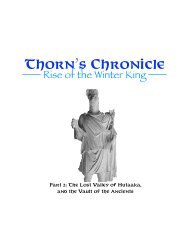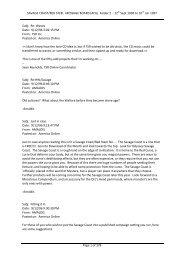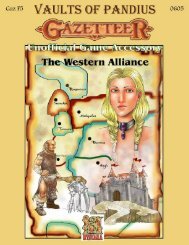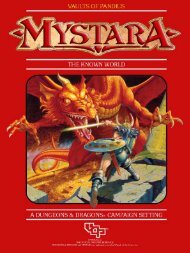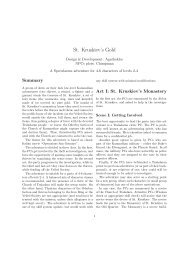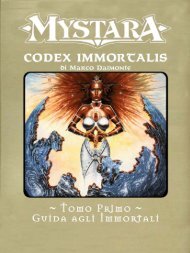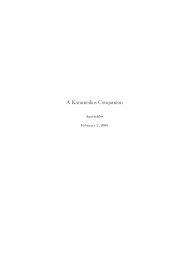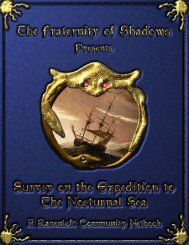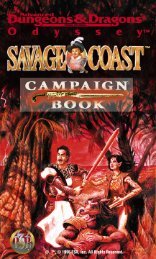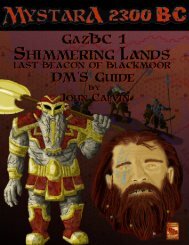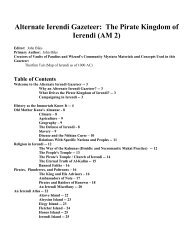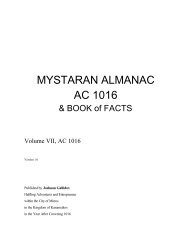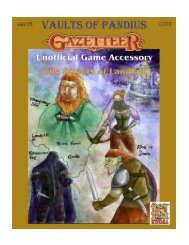Karameikos - Vaults of Pandius
Karameikos - Vaults of Pandius
Karameikos - Vaults of Pandius
Create successful ePaper yourself
Turn your PDF publications into a flip-book with our unique Google optimized e-Paper software.
The History <strong>of</strong> <strong>Karameikos</strong>The end <strong>of</strong> the Dark Age also saw the firstsuccessful attempt at uniting the Traladarancommunities into one kingdom. On the eve<strong>of</strong> a war against the humanoids, anticipatedby a time <strong>of</strong> renewed humanoid raids all overTraladara, Ban Ithron Zlatarev 31 succeeded inBC 195 to the throne <strong>of</strong> Volaga and managedto unify under his banner some <strong>of</strong> the otherprinces, leading them to victory over thehumanoids. In the following years, heexpanded his domain through force anddiplomacy to nearly all <strong>of</strong> Traladara, and inBC 171 he was crowned in Marilenev bypriests <strong>of</strong> the Traladaran patrons as “King <strong>of</strong>Traladara” – marking the first use <strong>of</strong> this titlein history. In BC 147 Ithron died, and hiskingdom would not outlive him for long; hissuccessors couldn’t manage to keep thequarrelsome clans united, and the kingdomslowly fragmented, until at the half <strong>of</strong> the 1 stcentury AC the title <strong>of</strong> king, by then empty,fell into disuse.Hostile humanoids were not the only ones tomigrate in the wild Traladaran lands. Anumber <strong>of</strong> rock gnomes led by theHilltopper clan, survivors <strong>of</strong> the slaughter <strong>of</strong>their own race perpetrated centuries beforeby the kobolds under the HardangerMountains, after many wanderings camefrom the north to Traladara around BC 100,and settled in the lands between theHillfollow and Windrush Rivers, where theybuilt their own settlements, the largest <strong>of</strong>which was called Highforge.The turn <strong>of</strong> the first millennium AC markedthe beginning <strong>of</strong> an age <strong>of</strong> rapiddemographic growth for Traladara. Both theconsolidation <strong>of</strong> the Thyatian Empire to theeast and <strong>of</strong> the Kingdom <strong>of</strong> Darokin to the31Ithron is mentioned in <strong>Karameikos</strong>: Kingdom <strong>of</strong> Adventure asone <strong>of</strong> the leaders that managed to claim the title <strong>of</strong> King <strong>of</strong>Traladara; his surname was created by me.north-west helped Traladara to enter amore stable age. From the 1 st to the 4 thcentury AC, the population began a slowbut steady process <strong>of</strong> resettlement <strong>of</strong> thewilderness – mostly the woods and theforests. Settlements grew and some <strong>of</strong> thembecame prosperous trade cities. Thanks toits plentiful natural resources - such aswood, furs, and precious metals - Traladarabegan to be frequently traveled bymerchants <strong>of</strong> neighboring countries, mostlyThyatians, Darokinians, and Minrothians.Even a Rockhome dwarven clan, theStronghollow - following rumors <strong>of</strong>precious metal veins to be mined below theAltan Tepes - came to Traladara, where itwas welcomed by the gnomes in theirKingdom <strong>of</strong> Highforge; the dwarves settledthere around AC 300. The increase <strong>of</strong> tradeand steady passage <strong>of</strong> people though landroutes improved the cultural unification <strong>of</strong>the Traladarans.Religion was another powerful factor <strong>of</strong>unity. Around AC 400, after centuries <strong>of</strong>cultural contacts, Thyatian missionaries ledby Lucor 32 - who subsequently was made asaint by the Church <strong>of</strong> Traladara - translatedinto Thyatian the Ballad <strong>of</strong> King Halav 33 .32The character <strong>of</strong> Lucor is mentioned in B6: “Advancing towardthe gate is the Procession <strong>of</strong> Lucor. The procession is a religiouscelebration honoring a legendary local cleric named Lucor. […]The festival is <strong>of</strong> great importance.” The story <strong>of</strong> Saint Lucor wasfurther developed by G. Agosta as part <strong>of</strong> the Fantasy Cities:Specularum project .33It’s unlikely that literacy was introduced by Thyatians this late.The Hollow World campaign setting, under the description <strong>of</strong>Milenian customs, says: “Milenian is the language <strong>of</strong> these people.Though it is descended from Traldar, it is not the same language.There is a written form <strong>of</strong> the language, which is not at all similarto the written form <strong>of</strong> Traldar.” So the Traldars did have a writtenlanguage; literacy among the Traldars surely suffered a hard blowduring the Dark Age, but some sort <strong>of</strong> literacy (based on the oldTraldar alphabet) may have resurfaced between BC 500 and AC400. Despite this, it may be that the Ballad was kept in oral formonly out <strong>of</strong> some religious tradition. I suppose that the translation<strong>of</strong> the Ballad into Thyatian marks the gradual adoption <strong>of</strong> theThyatian alphabet in the religious practices and then in theTraladaran tongue, in place <strong>of</strong> the old Traldar alphabet.53THRESHOLD: The Mystara Magazine Issue #1



